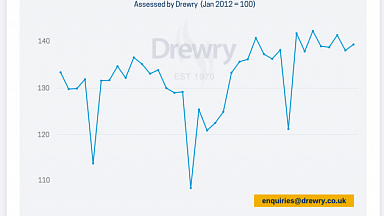Brief technical description
The border crossing point is an electrified line. Large-tonnage container transshipment yard has tracks with the 1,520 and 1,435 mm gauge and is equipped with 32 and 50-ton gantry cranes. Simultaneous handling of two trains on standard gauge can be performed. In this facility it is possible to transship 20 and 40-foot containers not only into wagons, but onto vehicles as well. Container yard length is 1,090 meters. There is also another yard where cargo is transshipped from open rolling stock, including wheeled units, timber and packaged goods. The terminal’s length is 500 meters, it is equipped with gantry cranes having lifting capacity of 10, 30 and 50 tons. Heavy-weight cargo yard is 100 meters long. 160-ton crane is available on the yard. Loose cargo is transshipped on the 350-meter open yard. For this purpose, rail-mounted grabbing cranes are used. Types of control: border, customs, vehicles, quarantine, phytosanitary and veterinary.
Covered hangar-type warehouse was built for cargo needing weather protection. The warehouse can hold 12 standard-gauge wagons and 12 wagons on the 1,520 mm gauge. Transshipment from one wagon to another is performed via diesel loaders. 360-meter covered loading platform is used. There are also automatic loaders operating in this area to ensure handling of packaged goods and unit loads from one wagon to another.
And, on the top of that, transshipment facilities for handling perishable cargo were arranged. The cargo is moved from one refrigerator wagon to another inside the hangar warehouse having effective length of 350 meters.
It is planned to arrange the group of 10 tracks with the 1,520 mm gauge, which is able to receive rolling stock with axial load of 25 tons and equipped with border and customs control points.
Brest-Tsentralny station (BUG)
Length of receiving-and-departure tracks with 1,435 mm gauge: 4 tracks at the Brest-Tsentralny station with a length of 34 to 60 conventional values
Length of receiving-and-departure tracks with 1,520 mm gauge: 5 tracks at the Brest-Tsentralny station with a length of 57 to 69 conventional values
Daily train receiving/departure capacity for the 1,520 mm gauge: 14 trains/14 trains
[1]
Exchanging is possible: yes
Brest-Severny station
Length of receiving-and-departure tracks with 1,435 mm gauge: 4 tracks with a length of 54 to 62 conventional values.
Length of receiving-and-departure tracks with 1,520 mm gauge: 2 tracks with a length of 65 conventional values.
The length of tracks for transshipment of containers with 1,435 mm and 1,520 mm: transshipment from the Brest-Severny station on 4 tracks with the 1,435 mm gauge with length of 42 to 66 conventional values
Daily container transshipment capacity: 942 TEUs (for direct option)
Daily train receiving/departure capacity for the 1,435 mm gauge: 15 trains/15 trains
[1]
Exchanging is possible: yes
Capacity
450,000 TEUs/year
Transshipment and paperwork time
21 hours
- Up/down, in the context West – East/East – West







